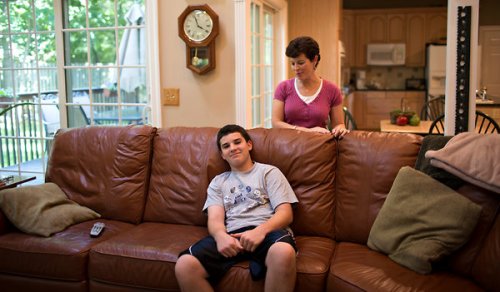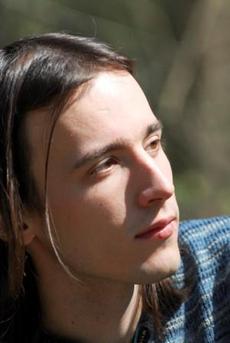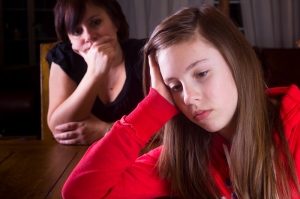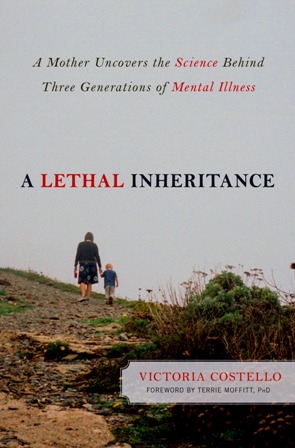 As the much debated DSM5 finally enters the hands of doctors, policymakers, insurers and other interested parties next month (MAY/2013), I am reposting an article I wrote last fall. It concerns what I and many other mental health advocates view as a grave DSM5 omission: keeping the proposed diagnosis of Attenuated Psychosis syndrome out of the list of recognized diagnoses. Yes, unlike the many critics of this handbook who have decried its inclusion of what they view as too many conditions, my beef is the exclusion of one with which I’ve had personal experience as a mother. With treatment, my son made a complete recovery from attenuated psychosis syndrome. Now, I shudder to think what this omission means for young people who are suffering the symptoms of early stage schizophrenia. One thing I am sure of: too many will continue to lack the benefits of insurance coverage and medical expertise that would be conferred by a DSM5 diagnostic designation. My post follows…
As the much debated DSM5 finally enters the hands of doctors, policymakers, insurers and other interested parties next month (MAY/2013), I am reposting an article I wrote last fall. It concerns what I and many other mental health advocates view as a grave DSM5 omission: keeping the proposed diagnosis of Attenuated Psychosis syndrome out of the list of recognized diagnoses. Yes, unlike the many critics of this handbook who have decried its inclusion of what they view as too many conditions, my beef is the exclusion of one with which I’ve had personal experience as a mother. With treatment, my son made a complete recovery from attenuated psychosis syndrome. Now, I shudder to think what this omission means for young people who are suffering the symptoms of early stage schizophrenia. One thing I am sure of: too many will continue to lack the benefits of insurance coverage and medical expertise that would be conferred by a DSM5 diagnostic designation. My post follows…
Attenuated Psychosis Syndrome will be included in the new DSM5 but only in its “Section 3,” a category of conditions designated as “needing further research.” Oddly, others in this category include: Internet use gaming disorder, Non-suicidal self-injury, and Suicidal behavioral disorder.
The really bad news: Section 3 disorders generally won’t be reimbursed by insurance companies for treatment, since they are still undergoing research and revision to their diagnostic criteria.
So after some three years of pitched battle in the professional and popular press, the revised diagnostic manual of The American Psychiatric Association (APA), has not approved this still controversial diagnosis. And since the DSM is revised only once a decade) that means it will be at least that long before the early stages of schizophrenia will again be considered for eligibility for reimbursable treatment. The very worst news in these developments is that even though early intervention is the best way to head off this chronic debilitating condition, many families will lack the information and resources to provide it.

This young man and his mother appeared on PBS Newshour to speak about the benefits of his treatment for attenuated psychosis syndrome he received at the SF PREP Clinic
Attenuated psychosis is a condition most often applied to young adults showing their first (thus weak or attenuated) psychotic symptoms; symptoms such as hearing voices, disordered thinking, paranoia and social withdrawal that could, if left untreated, lead to full blown schizophrenia or bipolar disorder. I’d hoped this revision of the DSM would take the full step of classifying it as a disorder so that more young people, like my now grown son Alex, would be able to receive treatment earlier rather than later when remission is more likely.
However, the reality is that attenuated psychosis will still be treated in cases when young peoples’ families can pay out of pocket for care; when a state or city offers subsidized “early psychosis” care often under the rubric of a research study (for example the UCSF PREP program, see below). Another more likely scenario is that a mental health provider will diagnose someone as having full blown schizophrenia when, in fact, he or she has not yet reached that standard (the situation for Alex at age 18), but the provider knows the patient will not have covered care without this diagnosis. Or the affected person will be diagnosed and treated for one of the presenting symptoms that often accompany attenuated psychosis, with depression, anxiety being the most common.
To provide details on how and why I arrived at the point of view that attenuated psychosis should be recognized as a disorder, I’ll repost here my article of last spring in which I advocate for this outcome.
What’s At Stake for Parents and Children in the DSM-5 (or DSM6) Battle?
Fevered debate over the final terms of the DSM5 may now be officially over but I have no doubt that many of the fiercest arguments that have surrounded it will continue unabated. I for one will continue to advocate for early recognition and treatment for psychosis. But even without this recognition, intervention for the first signs of psychosis is available on a limited basis worldwide.
There are now some 20 clinics and leading psychiatric hospitals in the U.S. (with many more in Europe, Canada, Australia and the U.K.) that have already established specialized treatment programs for treating early psychosis. Indeed, these are the programs that will likely produce the definitive data that will ultimately vindicate the change in diagnostic criteria that will enable wider treatment for early psychosis, thus sparing millions more youth from the full blown disorder of schizophrenia.
 One such pioneering program is the PREP program in San Francisco, affiliated with the University of California, San Francisco (U.C.S.F). I participated as a keynote speaker on June 8, 2012 in the 1st Annual PREP (Prevention and Recovery in Early Psychosis) Conference held in San Francisco. The day-long free educational event was designed for mental health practitioners, youth, parents and anyone else interested in learning the theory, symptoms/warning signs, methods of treatment of early psychosis in the 16 to 30 age group. (Click on the conference title above for more information about the PREP CLINIC and the conference.)
One such pioneering program is the PREP program in San Francisco, affiliated with the University of California, San Francisco (U.C.S.F). I participated as a keynote speaker on June 8, 2012 in the 1st Annual PREP (Prevention and Recovery in Early Psychosis) Conference held in San Francisco. The day-long free educational event was designed for mental health practitioners, youth, parents and anyone else interested in learning the theory, symptoms/warning signs, methods of treatment of early psychosis in the 16 to 30 age group. (Click on the conference title above for more information about the PREP CLINIC and the conference.)
One of the most confusing issues at the heart of the dispute over early psychosis diagnosis and treatment concerns the “false positive” argument: that is, the possibility that young people whose symptoms don’t progress to a full blown state of schizophrenia would be stigmatized by the diagnosis and then receive unnecessary treatment.
To these arguments, I would say first that people should not be forced to make decisions about their mental health based on whether that care will stigmatize them in the eyes of others. Secondly, I take issue with this notion of “unnecessary” treatment.
The False-Positive Straw Man
The possibility of a young person receiving a false-positive diagnosis for schizophrenia has worried plenty of people inside and out of the psychiatric profession. And there is good reason to take a close look at this issue. Based on the available studies, only one-third of young people with early symptoms of psychosis actually progress to a full-blown, more serious disorder—without treatment. At the center of this debate is the cost-benefit analysis of the early intervention option, usually intervening with cognitive behavioral therapy and/or antipsychotic medication.
The noted Australian early psychosis researcher Patrick McGorry pinned the vehemence of the current controversy on residue from other recent disputes within the American psychiatric profession. In 2006, he complained to Time magazine that while research and funding to support early psychosis treatment is blossoming in other countries, “it has ground to a halt” in the United States. “They’ve clouded the issue with the whole business of overmedication of younger children for ADHD,” he said.
To confirm McGorry’s assessment of what’s behind American psychiatry’s hysteria around expanding the diagnosis for psychosis one need only listen to the dire predictions of Allen Frances, the editor of the last DSM edition, who has led the charge to exclude the “attenuated psychosis” diagnosis from the DSM-5. Frances has written that early intervention would cause “a wholesale medical imperialization of normality,” and create a “bonanza for the pharmaceutical industry,” for which “patients would pay a high price [of] adverse effects, dollars, and stigma.” Frances said he regrets the role played by the DSM-IV in creating “the bipolar fad” of the last decade by opening up that diagnosis to children and adolescents. More recently Frances has characterized the concept of prevention in psychiatry as little more than a pipe dream, certainly grossly premature in the case of attenuated psychosis.
Defending his work with early psychosis and the concept of prevention, McGorry explained, “It’s unacceptable to wait for patients to slide into madness, though it’s impossible to predict with any certainty which ones will. You’ve got to do something.” By this, he seemed to mean adding an antipsychotic medication to the treatment mix.
I appreciated McGorry’s clear understanding of just how miserable his patients typically are while they struggle with the onset of psychotic symptoms. In the Time article, I found his description picture-perfect: “They’ve got no friends. They’re sitting alone in their bedroom, their lives passing them by. You’ve got to actively research what’s going to help them. The critics have been right to raise issues, but you can’t neglect people when they clearly have a disorder, just because you can’t technically fit them into our arbitrary system of classification.”
Since his original clinical trial, McGorry and his Australian colleagues have gone on to treat many more young people who are at ultra-high risk for psychosis. Some guardedly good news has emerged from these recent trials. The six-month transition rate to psychosis, which was a 34 percent rate in McGorry’s earlier trials, had, by 2010, dropped to 9.2 percent. What does it mean? McGorry speculates that this drop in conversions correlates with many of his patients being identified earlier in their disease processes. As a result, he thinks they respond better and quicker to the interventions they’re getting. McGorry does not think, as some of his critics assert, that most of these young people were “false-positives” when they first entered treatment.

Alex Self Portrait at 17
I would like to put a human face on this concept of the “false-positive.” Let’s say a young person comes for treatment with pre-psychotic symptoms including paranoia, weak hallucinations, depression, social withdrawal and the beginnings of disordered thinking–all would fit under an “attenuated psychosis syndrome” diagnosis. Depending on how long his symptoms had been going on and how frequently they occur, under the proposed treatment model, he would be deemed at “high risk” of developing full blown schizophrenia. As a first stage treatment, he would then receive up to six months of cognitive behavioral therapy and possibly participate in family therapy to help him and his loved ones manage and hopefully arrest these symptoms. He would not receive antipsychotic medication unless and until his symptoms worsened or continued unabated after several months of CBT. Without knowing whether this young man’s symptoms would have progressed to full blow SZ the question is then: was the treatment he received a net loss or gain to him and his family?
The Definition of “Staged Treatment”
These days, McGorry is very careful to describe his treatment approach as strictly “needs-based.” He outlines a clinical staging model, in which an individual’s treatment moves from one stage to the next only after his symptoms escalate. After determining that the individual meets the criteria of ultra-high risk—someone between the ages of sixteen and thirty who is experiencing attenuated symptoms of psychosis, or is within a year of a first psychotic episode—the first stage of care he receives at McGorry’s clinic is cognitive behavioral therapy and the daily intake of omega-3 fish oil, a readily available nutritional supplement that has been shown to be effective in treating early psychosis, likely by enhancing the ability of the brain’s synapses to communicate. Antidepressants will also be considered if the young person’s depression is present and severe, and she doesn’t respond to CBT. And then, if indicated, McGorry recommends a very low dose of antipsychotic medication, ideally for a limited period of time of six weeks.
If this approach to medical care sounds familiar, that’s because it is the way most medical conditions are treated. Think about the treatment of high blood pressure as a precaution against strokes and heart attacks. Consider the removal of pre-cancerous tissues as a defensive move against tumors.
This same staged model for treating early psychosis has now been replicated and studied in a growing number of national health systems and university-affiliated clinics in the United States, United Kingdom, Europe, Scandinavia, and around the world. From the outside, it looks to be a constant balancing act between risk and benefit; the codifying of each symptom and step of treatment into a fixed clinical protocol an ongoing process—with a high level of cooperation by clinicians working and communicating with each from early intervention clinics around the world.
 Who Seeks Early Psychosis Treatment and Why?
Who Seeks Early Psychosis Treatment and Why?
“Anywhere but here” is the refrain heard from the majority of teenagers who, if given a choice, would give serious thought to cutting off a finger before agreeing to see a “shrink.” Demian Rose in his role as medical director for PREP San Francisco offers an insight into how and why young people initially arrive at his clinic for care, explaining that most don’t come because they’re failing at school, or even because they’re hearing voices. These fleeting psychotic symptoms no doubt fuel their anxiety and depression, but most come for an evaluation, Rose says, “when they become socially isolated and emotionally distant from their peers.” Research confirms that mood fluctuations and stress trigger and exacerbate the recurrence of psychotic symptoms in those at risk.27
The good news may be that since friendships and budding romantic feelings are such a priority to adolescents, when this area of their lives gets messed up, they have a greater motivation to get evaluated and treated. In the process, they may stave off the psychosis that could be laying in wait.
The Important Role of Psychotherapy in Pre-Psychosis Treatment
The therapeutic goal at PREP is to help the psychologically distressed individual (around ten to one are male) retrain and reframe his thoughts and behaviors toward more socially acceptable habits.28 This is also the essence of the cognitive behavioral therapy (CBT) used with young people who are treated at PREP. This form of psychotherapy has been around for decades, but it has only recently been adapted by psychologists in the United Kingdom for the treatment of psychosis. (CBT in its original form is a widely used form of talk therapy to treat most other common mental disorders, including depression). As adapted for psychosis, CBT teaches an individual who becomes suspicious or paranoid to become consciously aware of a negative thought pattern that is about to escalate and then to learn how to “catch it, check it, change it.”
Imagine that a young man who is experiencing fleeting psychotic symptoms is sitting on a packed bus at rush hour. In his discomfort at the crowd pushing up against his knees, he might acquire the distinct feeling that the middle-aged woman standing a few feet away is staring at him, angry that he has a seat and she doesn’t. He may also fear that she’s scrunching up her nose because she believes he smells badly. He could go off even further on this paranoid tangent, becoming suspicious she will report him to the bus driver, who will request he get off at the next stop.
Before saying something inappropriate to the woman or getting up to leave the bus preemptively to avoid the feared outcome, CBT teaches this young man to stop and catch his wayward thought process. Checking to see if there’s any other viable explanation for the woman’s behaviors then reveals to him the more likely possibility that the woman simply has nowhere else to look but in his direction. Further, he realizes that there’s no concrete evidence to support the belief that she blames him for her situation or judges his appearance negatively—nor that she has any intention to speak to the bus driver about him. This reframing allows the young man to change his thoughts and to then relax his mind and body for the duration of the bus ride. It’s the CBT mantra in action: “Catch it, check it, change it.”
Demian Rose, Rachel Loewy, and their colleagues writing in Current Psychiatry use a continuum model to demonstrate how the human spectrum of thought and perception ranges from ordinary to heightened and then on to varying degrees of psychosis. They demonstrate how a clinician can respond to a young person’s unusual comments or behaviors without “pathologizing” his behavior and risk alienating him. This approach offers the client perspective and a choice. On one hand, he can continue expressing his unusual thoughts openly and risk alienating others. Or he can choose to keep these thoughts to himself and gain social acceptance. Rose points out that in the prepsychotic stage, this interactive discussion and decision-making process is much more viable.
This same advice can be useful to parents of an adolescent or a younger child whose altered behavior or speech might suggest that he is close to this outer edge of the continuum. Putting science aside, I remember as a parent watching Alex in this state, and it was terrifying. As he left “reality” behind, I felt him slipping away from me, too. But the alternative to pathologizing this behavior, Demian Rose points out, is normalizing it,which allows you to open up an honest conversation with your child (or another adult) about thoughts and feelings that may not fit our definition of normal but may in fact be very human. I didn’t have this insight to guide me at the time, but it made perfect sense when I heard Rose explain that this sort of conversation is the best way to find out what someone in this state is feeling and thinking, and what he really needs from you.
In addition to training their clients to use this thought-reframing drill, the PREP program also includes family members and caregivers in ongoing treatment. The model calls for bringing the clients’ parents and other family members together in a regularly meeting “multi-family group.” There they receive psychoeducational treatment, meaning they learn about psychosis and how they can help the affected person stay on track. Getting together with other families provides much-needed emotional support to parents faced with the often daunting task of providing care a troubled adolescent.
 The Role of the Family
The Role of the Family
The man credited with developing this model is William McFarlane, a pioneer in early intervention for psychosis whose PIER Clinic (Portland Identification and Early Referral) was established in Maine in 2000. McFarlane’s studies show that ongoing support groups made up of several families meeting together significantly reduces relapse rates for the schizophrenic family member—when compared to not involving families in care or offering psychoeducational support to one family at a time. The PIER program was also the first to demonstrate that teachers, social workers, pediatricians, and therapists in a community could be trained to successfully identify psychotic symptoms in distressed young people and then intervene by referring them to PIER for an evaluation.
The Medication Issue
When an adolescent is diagnosed properly as “ultra-high risk,” he may be as little as a month or as long as one to two years away from developing full-blown schizophrenia—if he is going to convert at all.Demian Rose put the clinician’s dilemma succinctly: “The problem with the current diagnostic standard is that it ‘waits’ until it’s absolutely sure that dysfunction has been present for 6 months before confirming schizophrenia; so the message to parents and patients is all too often: ‘Let’s wait this out. You’re either going off a cliff. Or you’ll be okay. We’re not sure which.’ The real question should be how can clinicians reduce the risk of conversion while minimizing the risk and burden of any treatments.”
One guiding principle at PREP is to use as small a dose of antipsychotic medication as possible to keep the individual stable, and to err on the side of less is more.31 Convincing clinical data is accumulating on the positive outcomes coming from clinics using the approach practiced at PREP. Those who get treatment within the first six months to a year of the appearance of symptoms of psychosis show a much higher rate of remission and long-term recovery. If their symptoms convert to a diagnosis of full-blown schizophrenia (the usual diagnosis if they do) or bipolar disorder, their treatment is usually more effective, meaning their impairments are less, and their recovery is greater over the long term. But if they receive the same treatment from one to three years after psychosis has firmly taken hold, the rate of remission is lower, and the risk of side effects from long-term use of the medication goes up.32
Now in its second year of operation, the PREP program has treated thirty young people, ages sixteen to thirty, with a mean age of twenty-two years. Twenty-one of these patients had already progressed to full-blown schizophrenia before coming to PREP, but they were recent-onset patients. Nine hadn’t yet reached that threshold, and so were considered ultra-high risk.33 In the future, if the PREP-PIER model is permitted to become the standard for mental health care, we could reasonably expect this ratio to reverse; more young people could receive help before going “over the cliff” into a full psychotic episode, not after. Then their care could begin with CBT and be far less likely to progress to medication, at least not for a long period. The important thing is that they would learn the necessary self-regulating skills to stay safe.
In a professional journal, Thomas McGlashan, who led a clinical trial in early psychosis treatment at Yale and came out with what he saw then as disappointing results, nonetheless laid out the evidence for argument to treat young people for their symptoms of early psychosis as follows: (1) the patients are currently ill, (2) the patients are at high risk for getting worse, (3) no DSM-IV diagnosis accurately captures their current illness or future risk, (4) the diagnosis has been made with reliability and validity in the research setting, and (5) placement in DSM-5 would help promote the needed treatment and prevention research to enable articulation of a standard of care to benefit these patients and their families. He closed by pointing out that any potential harms can be minimized by patient, family, and provider education.
To my ears, this debate comes down to the question of who has the right to decide when an individual and a family have suffered enough. By continuing this now very public, fever-pitch argument over the difficult choice of whether to give a child or teenager a psychiatric medication, I think we’ve lost sight of what’s really at stake here. As Doctors McGlashan, McGorry, and Rose make clear, these young people are already very ill when they come seeking help. My sense of urgency comes from having watched my son Alex’s two painful years of decline until he became a shadow of his former self. And having the joy of watching him climb out of that state after three years on medication and in intensive CBT therapy. No young person should have to stay in that state any longer than necessary.
I think many of the dire predictions of those opposed to recognizing attenuated psychosis as a diagnosable and treatable syndrome — those fearing its over diagnosis and the over medication of young peple — should in fact be accepted as valid cautionary messages for their professions — not as a reason to deny people care who desperately need it.
The lack of a recognized diagnosis for early psychosis in the DSM-5 will not stop parents and their affected adolescents from seeking and getting help for those symptoms. It will just keep the process of getting help expensive and difficult and limited the number who can be helped in time to stave off the possibility of developing a full blown disorder.
In other words, it will stay par for the course for American medicine. But that doesn’t mean parents and advocates shouldn’t continue the campaign to educate and lobby for change.
For comprehensive NEWS on early treatment of schizophrenia and a list of hospitals and clinics treating early psychosis in the US and around the world visit the website http://www.schizophrenia.com
For more information on the PREP Clinic.

[Some of this article is drawn from my book, A Lethal Inheritance, A Mother Uncovers the Science Behind Three Generations of Mental Illness.]



 This dramatic improvement for traumatized youth in one of the worst places for children on the planet, Congo, is testimony to the power of psychotherapy to help someone heal from abuse and neglect. I can’t tell you how much this cheers me to read. Think about what it might mean for trauma exposed children here in the U.S. and everywhere to receive such concerted mental health care.
This dramatic improvement for traumatized youth in one of the worst places for children on the planet, Congo, is testimony to the power of psychotherapy to help someone heal from abuse and neglect. I can’t tell you how much this cheers me to read. Think about what it might mean for trauma exposed children here in the U.S. and everywhere to receive such concerted mental health care.
You must be logged in to post a comment.